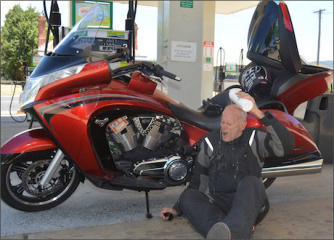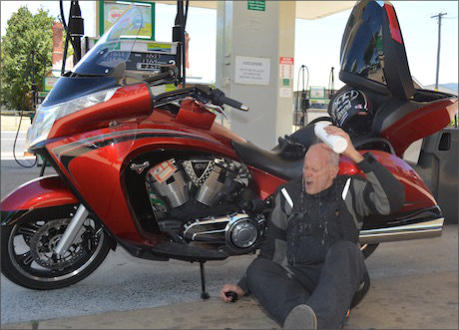


Staying cool when riding in the heat of the summer
SHARE WITH US
Copyright © 2025 - Ozark Rides, All Rights Reserved




For me riding is a year-round event, even in the coldest months during the winter. To be fair I will say that I
wear electric liners from the tips of my toes to the tips of my fingers. As long as the roads are clear I will ride
and stay warm. But what do you do when the temps are 90 + degrees and you just need to ride?
So how do you stay cool when the temps mimic the seventh circle of hell? Here are some time-tested proven
tips that will help you stay cool.
Dress properly and keep your skin covered.
Seems like simple, advice, but it’s amazing how many people don’t follow it. Any areas of skin that are exposed
will be much harder to cool, as the sweat will evaporate from the air rushing over it at speed. This means you’ll
dehydrate faster. It may seem counterintuitive to cover yourself with clothes in the heat, but look at the
Bedouins in North Africa – they’re covered head to toe. Of course, on a motorcycle you need to wear abrasion
and impact resistant gear, which can be heavy. In high-heat conditions, I wear a long-sleeved, tight-fitting
exercise shirt made of moisture-wicking material. I know that it seems ridiculous to wear long sleeves, but as
long as you have air moving over the fabric, it will work great. As sweat evaporates, it takes your body heat with
it. Moisture-wicking material draws sweat away from the body to be evaporated through the shirt, aiding the
cooling process. Conventional materials can simply trap sweat next to the skin, limiting evaporation. The key to
these materials is air flow. If there is no air movement over the material, then the shirt will become oversaturated,
and sweat will not evaporate, in my experience, the people who are effected most by the heat are those who don’t
cover themselves properly. Use cooling gear. These days, technology has given us some awesome tools to fight
off the heat, like cooling vests, collars, and even wrist bands, which absorb water into special moisture-retaining
fabric and help keep your body cool for hours.
Include stops on your route where you can cool off.
One of the best ways to rejuvenate yourself is by getting out of the heat, into a cooler environment. You meet
interesting people in rural convenience stores, and many have large ice freezers outside. Placing our helmets in
the freezers while we go inside for a cool drink. A quick stop can enable you to ride another 45 minutes even in
the worst heat, so plan your ride along roads that have services and conveniences no more than 1/2 hour apart.
If it’s in the 100’s and you’ve got a two hour ride before your next stop, you’re putting yourself through
unnecessary misery and risk.
Bring more water than you think you’ll need.
Water is vital for keeping the body cool, but it's also necessary
for digestion, for flushing toxins out of your body, and for
lubricating your joints. It also cushions your organs and tissues,
so when you get dehydrated, your body just won’t work
properly, things will start to shut down, and you’ll physically
crash. The worst thing is that by the time you start feeling bad,
you’re already in trouble, so it’s HUGELY important to stay
hydrated. That means drinking plenty of water before you get
on the bike, and consuming 1 liter of water every hour,
especially in extreme temperatures. We try to get water that
includes electrolytes (like SmartWater) to help replenish vital
minerals that are lost when you sweat profusely.
Only Water is Water: Caffeine and alcohol are diuretics, which
cause you to urinate and lose more water. When it’s hot, steer
clear of sugary drinks, caffeine, and alcohol. Also, never drink alcohol directly before or during your ride.
Watch very carefully for signs of Heat Exhaustion and Heat Stroke.
Your body will send you signals that it’s having trouble with the heat, which can include cramps, nausea,
headaches, extreme fatigue, flushed or pale skin, dizziness, and heavy sweating. Left unchecked, you can develop
Heat Exhaustion, which is a form of mild shock. If you’re feeling these symptoms, it’s time to pull over, rehydrate,
rest and recover for as long as it takes. Don’t be in a rush to get back on the bike – sometimes a rider doesn’t
want to inconvenience their friends by holding things up. How long do you think a trip to the hospital will hold up
the ride? If Heat Exhaustion is allowed to develop into Heat Stroke, you’re in big trouble. Your cooling system
shuts down, and body temperature can rise to as high as 105 degrees. Brain damage is possible and at the very
least, you’ll likely have an erratic pulse and trouble breathing. People with Heat Stroke often pass out – not
something you want to happen when you’re riding. Riding in really hot weather is not bad when you’re prepared
for it. Remember to hydrate, keep your skin covered, and avoid hazards. Don’t let the heat weaken you to the
point where you’re not fully attentive to traffic conditions and the road. Basically, you must consider how your
body will deal with the heat. Reducing the effects of convection, through covering up and wetting down, will
reduce the amount of heat that your body must deal with through evaporation. Covering up in the heat will keep
you cool. Hot weather usually means lots of sun exposure, so get some good sunglasses or a darkened visor to
prevent headaches caused by sun glare. And don’t forget to put sunblock on the back of your neck and anywhere
your riding gear leaves the skin exposed.
Ride safe. Ride aware.






Copyright © 2025 - Ozark Rides, All Rights Reserved


Staying cool when riding in
the heat of the summer
For me riding is a year-round event, even in the coldest months
during the winter, to be fair I will say that I wear electric liners
from the tips of my toes to the tips of my fingers. As long as the
roads are clear I will ride and stay warm. But what do you do
when the temps are 90 + degrees and you just need to ride?
So how do you stay cool when the temps mimic the seventh circle
of hell? Here are some time-tested proven tips that will help you
stay cool.
Dress properly and keep your skin covered.
Seems like simple, advice, but it’s amazing how many people
don’t follow it. Any areas of skin that are exposed will be much
harder to cool, as the sweat will evaporate from the air rushing
over it at speed. This means you’ll dehydrate faster. It may seem
counterintuitive to cover yourself with clothes in the heat, but
look at the Bedouins in North Africa – they’re covered head to toe.
Of course, on a motorcycle you need to wear abrasion and impact
resistant gear, which can be heavy. In high-heat conditions, I
wear a long-sleeved, tight-fitting exercise shirt made of
moisture-wicking material. I know that it seems ridiculous to wear
long sleeves, but as long as you have air moving over the fabric,
it will work great. As sweat evaporates, it takes your body heat
with it. Moisture-wicking material draws sweat away from the
body to be evaporated through the shirt, aiding the cooling
process. Conventional materials can simply trap sweat next to the
skin, limiting evaporation. The key to these materials is air flow.
If there is no air movement over the material, then the shirt will
become oversaturated, and sweat will not evaporate, in my
experience, the people who are effected most by the heat are
those who don’t cover themselves properly. Use cooling gear.
These days, technology has given us some awesome tools to fight
off the heat, like cooling vests, collars, and even wrist bands,
which absorb water into special moisture-retaining fabric and help
keep your body cool for hours.
Include stops on your route where you can cool off.
One of the best ways to rejuvenate yourself is by getting out of
the heat, into a cooler environment. You meet interesting people
in rural convenience stores, and many have large ice freezers
outside. Placing our helmets in the freezers while we go inside for
a cool drink. A quick stop can enable you to ride another 45
minutes even in the worst heat, so plan your ride along roads that
have services and conveniences no more than 1/2 hour apart.
If it’s in the 100’s and you’ve got a two hour ride before your next
stop, you’re putting yourself through unnecessary misery and risk.
Bring more water than you think you’ll need.
Water is vital for keeping the body cool, but it's also necessary
for digestion, for flushing toxins out of your body, and for
lubricating your joints. It also cushions your organs and tissues,
so when you get dehydrated, your body just won’t work
properly, things will start to shut down, and you’ll physically
crash. The worst thing is that by the time you start feeling bad,
you’re already in trouble, so it’s HUGELY important to stay
hydrated. That means drinking plenty of water before you get
on the bike, and consuming 1 liter of water every hour, especially
in extreme temperatures. We try to get water that includes
electrolytes (like SmartWater) to help replenish vital minerals that
are lost when you sweat profusely.
Only Water is Water: Caffeine and alcohol are diuretics, which
cause you to urinate and lose more water. When it’s hot, steer
clear of sugary drinks, caffeine, and alcohol. Also, never drink
alcohol directly before or during your ride.
Watch very carefully for signs of Heat Exhaustion and
Heat Stroke.
Your body will send you signals that it’s having trouble with the
heat, which can include cramps, nausea, headaches, extreme
fatigue, flushed or pale skin, dizziness, and heavy sweating. Left
unchecked, you can develop Heat Exhaustion, which is a form of
mild shock. If you’re feeling these symptoms, it’s time to pull
over, rehydrate, rest and recover for as long as it takes. Don’t be
in a rush to get back on the bike – sometimes a rider doesn’t
want to inconvenience their friends by holding things up. How
long do you think a trip to the hospital will hold up the ride? If
Heat Exhaustion is allowed to develop into Heat Stroke, you’re in
big trouble. Your cooling system shuts down, and body
temperature can rise to as high as 105 degrees. Brain damage is
ossible and at the very least, you’ll likely have an erratic pulse
and trouble breathing. People with Heat Stroke often pass
out – not something you want to happen when you’re riding.
Riding in really hot weather is not bad when you’re prepared for
it. Remember to hydrate, keep your skin covered, and avoid
hazards. Don’t let the heat weaken you to the
point where you’re not fully attentive to traffic conditions and the
road. Basically, you must consider how your body will deal with
the heat. Reducing the effects of convection, through covering up
and wetting down, will reduce the amount of heat that your body
must deal with through evaporation. Covering up in the heat will
keep you cool. Hot weather usually means lots of sun exposure,
so get some good sunglasses or a darkened visor to prevent
headaches caused by sun glare. And don’t forget to put sunblock
on the back of your neck and anywhere your riding gear leaves
the skin exposed.
Ride safe. Ride aware.





MENU




